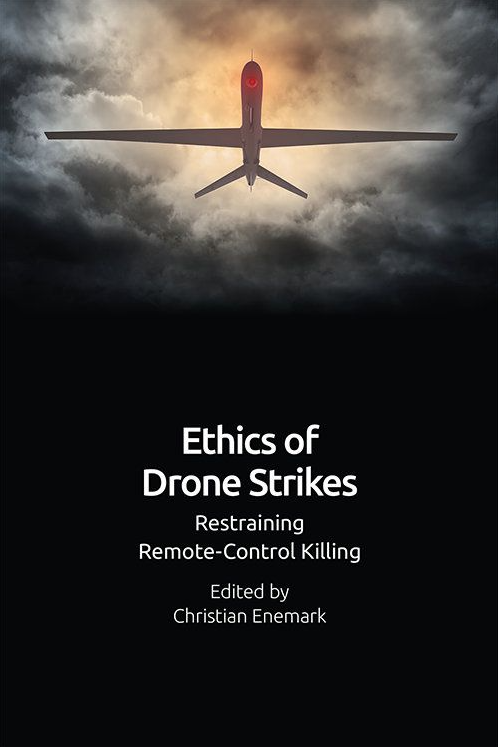by Christian Enemark (ed.) Edinburgh: Edinburgh University Press, 2021. IX + 204 p

The increasing use of armed drones has raised a series of ethical and legal questions. The fast-evolving development and sophistication of technologies that drones combine (aerospace, robotics, satellites, artificial intelligence) have stimulated intensive debates about the need of international regulation, tackling the challenge of drone violence moral status for ensuring compliance with international law. In particular with regards to armed drones, academic literature has problematised the advent of the “drone warfare”. To this discussion, this edited volume offers different “ways of thinking ethically” about current and future use of lethal drones. Contributions are organised around four key dimensions of drone strikes, namely as part of a war; as violent law enforcement; conducted by drone operators; and enabled by artificial intelligence (AI).
To discuss the theme of war, Robert Sparrow, in chapter 1, looks at the philosopher Paul Kahn’s main contributions, “War and Sacrifice in Kosovo” (1999) and “The Paradox of Riskless Warfare” (2002). Since armed drones were not officially used during the 1999 Kosovo war yet, these articles examine the use of airpower as a case of asymmetric warfare; they nevertheless became the academic references for the debate on targeted killing and drone warfare. Sparrow concludes that even if Kahn’s central argument was mistaken, his analysis remains inspiring for the debate on the ethics of drone warfare. In chapter 2, Christian Nikolaus Braun proposes a third way approach to the “Just War” theory to address moral concerns related to the use of armed drones, requiring a redefinition of the criteria “sovereign authority”, “just cause” and “right intention” in the light of targeted killings.
‘This edited volume offers rich, innovative and complementary analyses that guide the reader through the complex reality of armed drones’ usage and their future developments’
To examine whether drone strikes are military or law enforcement responses to terrorism, Max Brookman-Byrne, in chapter 3, assesses US drone strike campaigns in Yemen and Somalia from the perspective of international law and human rights. Considering their law enforcement nature and specific context in which they are used, he argues that what he defines as policing operations should be regulated by the more restrictive rules of international human rights law, especially as they resemble “colonial-era programmes” of air control. Also under the pretext whether lethal acts qualify as part of war or law enforcement paradigms, Christian Enemark, in chapter 4, is interested in personality strikes conducted by the US government since 2002. Considering the concept of “wild justice”, i.e. a form of violent law enforcement whereas the rule of law is weak, he suggests that circumstances and conceptualisations are necessary to determine which set of rules related to humanitarian law in wartime and more permissive or human rights law in peacetime and more restrictive should be considered. Eventually, in case uncertainties remain, he recommends to rather take the non-war posture for analysing drone violence to reduce the scope of “arbitrary killings”. Similar to this US-focused standpoint, Christopher J. Fuller shows in chapter 5 that the UK’s use of lethal drones in foreign territories relates to a specific legal position on self-defence, justice and imminence as well, irrespective a weaker domestic legal authority held by the UK prime minister compared with the US president.
Shifting to the perspective of the drone operator, Peter Olsthoorn, in chapter 6, questions the relevance of traditional military rules, virtues and ethics in the light of drone operators’ reality and concludes that factors such as courage and loyalty are not any longer central in drone warfare. From the feminist ethics of care perspective, Lindsay C. Clark and Christian Enemark highlight in chapter 7 the individual and relational dimensions of violent drone use, taking into consideration the non-physical harm effects on both, the “innocent others” and the drone operators themselves. Such moral reasoning, considering non-physical harm to civilians and shifting the focus on humans and their relationships, could transform the conduct of war with a new drone ethics, the authors argue.
The last two chapters finally address ethical challenges emerging from potential drones strikes relying on AI. Peter Lee, in chapter 8, examines the trend towards increasing autonomous elements in military drone systems. Questions concerning the degrees of autonomy, latent biases or accountability in lethal autonomous weapon systems (LAWS) require guiding (and binding) principles for their development and use as integral part of ethics and laws of war. In a similar line of thought, Thompson Chengeta, in chapter 9, recapitulates the international debate on autonomous armed drones (AADs), commonly known as killer robots, and evaluates the probabilities to adopt a regulatory framework. Discussions in this direction are already taking place within the UN Convention on Certain Conventional Weapons (CCW), yet the herein required consensus of all parties concerned makes decisions lengthy and sometimes unlikely. This is already a key explanatory factor of the lack of progress, as CCW is the preferred forum by powerful states to secure their political interests in AAD use. A further issue is the public acceptability of AADs, especially in the context of arms race in AI military technologies. Hence, Chengeta concludes that it is most unlikely of seeing the adoption of a regulation on AADS within the CCW.
Based on insights from each chapter, editor Christian Enemark concludes the volume by highlighting once again the need for better governance, but also in assessing the meaning of risk and categorisation of drone violence. Overall, this edited volume offers rich, innovative and complementary analyses that guide the reader through the complex reality of armed drones’ usage and their future developments; and equally important, it also contributes to the essential debates about drone ethics and legal framework challenges.
Chantal Lavallée is Assistant Professor, Royal Military College Saint-Jean, Canada